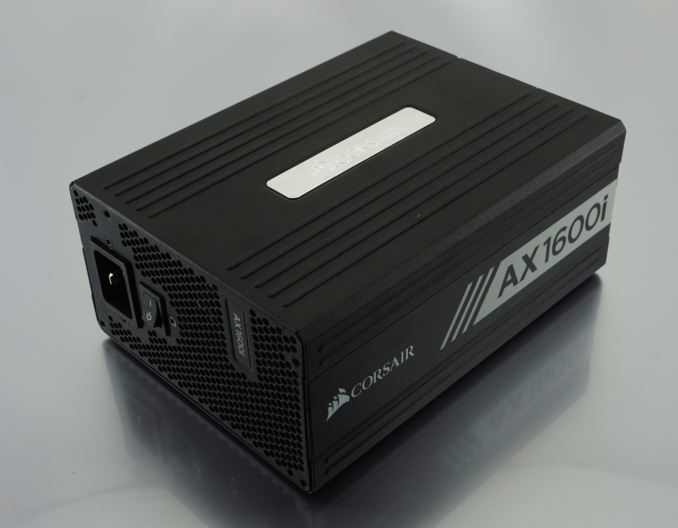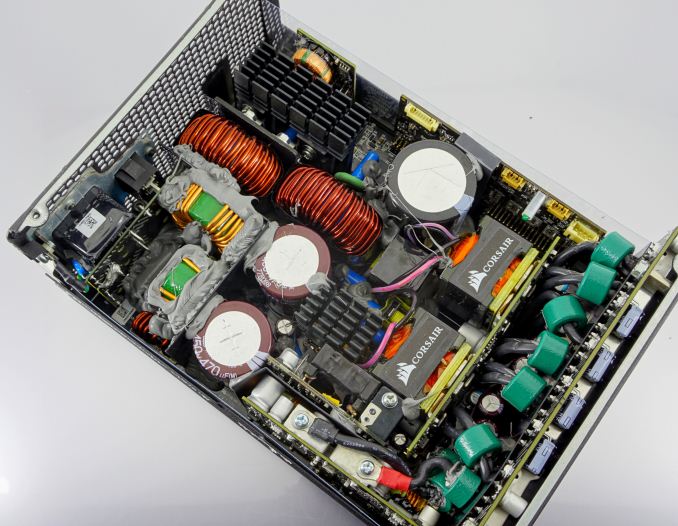The Emperor of Efficiency: Corsair's AX1600i PSU Rules Alone (Review)
by E. Fylladitakis on April 18, 2018 9:30 AM ESTConclusion
Corsair's intent behind the creation of the AX1600i was to create a product that is technologically and qualitatively superior than anything else in the consumer's market, with little regard for its production cost and, ultimately, the retail price. It is the kind of product aiming to please just a select few who want to build top-tier gaming systems or workstations regardless of the monetary cost.
Technologically, the AX1600i undoubtedly is the most advanced PSU that is currently available to consumers. The Gallium Nitride (GaN) parts are smaller, lighter, and significantly more efficient than their classic silicon-based counterparts. Their use allowed Flextronics (and ultimately Corsair) to design a platform that combines better overall performance and higher output into a smaller chassis. The end result is a PSU that is no larger than most 800W designs and yet is capable of delivering twice that power output without flinching. GaN parts are greatly more expensive than their silicon-based counterparts but the final product's cost was partially offset by the reduction in size and cooling requirements, allowing Corsair to maintain the price of the AX1600i at relatively reasonable levels.
The overall performance of the AX1600i is incomparable to that of classic PSU designs. Even the top tier models from other known manufacturers would have a hard time competing with the AX1600i on a single performance aspect - let alone every aspect. The power quality is textbook, with barely any voltage ripple appearing on any of the lines and under any load, while the voltage regulation is practically ideal. The very high electrical efficiency of the platform not only minimizes energy waste but also allows the PSU to operate very quietly and maintain low internal temperatures even when heavily loaded. Its very high quality parts are almost completely unaffected by environmental factors, ensuring that the AX1600i will perform 100% even in harsh environments. Taken altogether this means that the AX1600i has no peer; simpy put, its performance is unparalleled.
Corsair's flagship combines the best possible overall performance with exceptional quality parts, fashioning the best consumer PSU that money can buy. However, the AX1600i's true enemy is itself. With a price tag of $500 and a power output of 1600 Watts, the PSU is both preposterously expensive compared to regular designs and has a power output that will be vastly oversized for almost every kind of user. Only a system with a very powerful CPU and at least four top-tier graphics cards will be able to reasonably load an AX1600i, and these systems are quickly becoming a relic as NVIDIA scale back on SLI & CrossFire support. Instead we'd be looking at edge cases such as heavily overclocked systems with a smaller number of video cards, or someone who needs a lot of Titan Vs for productivity purposes.
Still, Corsair's move to GaN components signifies a very important milestone, as it is very likely that we will be seeing them implemented in less powerful units in the near future. They will be especially useful in SFX designs, as they will be able to deliver a high power output very efficiently, allowing the creation of quiet SFX units for living room gaming systems.












39 Comments
View All Comments
bill.rookard - Wednesday, April 18, 2018 - link
Ideally, a proper sized PSU is double the wattage of the total of everything running full tilt. All PSUs hit their max efficiency at 50% load, so if you have a 100w CPU, a single 150w GPU, add in a few HDDs/SSDs (10w each) and motherboard (50w), your average single GPU/CPU system will be 300-350w. Double that is 600-700w. So on average (since most people have a similar config) that should be the most popular size.I can't even imagine a system which would be pulling 800-900w directly. I could probably do it with my computer which I do the folding on (Xeon 3470 @ 4.2ghz, Asus P7F7E-WS) which could easily do a quad-SLI setup... but I'd have to get a quad set of 1070's or 1080's to break 900w nominal.
DanNeely - Wednesday, April 18, 2018 - link
You only want double max if your computer is almost always running at full load. IF you're not folding/mining/etc 24/7 and leave it on at idle you're paying a very large efficiency penalty most of the time. The low draw side of the efficiency curve is much worse than the high draw one (it's driven by fixed wattage loads vs the conversion efficiency that sets the peak, and temperature penalty that causes the slow drop off at max). In those cases 30-50% over will hit the sweet spot for efficiency, and if you have cheap power and don't load it a lot 15-20% may have the lowest total cost of ownership. You don't want to go much below that because running at maximum load also puts maximum stress levels on the PSU which will lead to faster aging and earlier death. (If you were foolish enough to get a no-name PSU loading it to just under max and keeping it there might let the magic smoke out if the number they put on the box is a peak power draw limit not a sustained power draw limit like it is in any half decent model.)zodiacfml - Thursday, April 19, 2018 - link
Correctnowwhatnapster - Friday, April 20, 2018 - link
Corsair link shows 700-725 watts pull for a Ryzen 1800x, 2x 1080ti ftw3, 1 ssd, 4x noctua case fans, stock clocks. @96% efficiencyA quad setup (although technically unsupported on 10xx series) would be closer to 1100w
Holliday75 - Wednesday, April 18, 2018 - link
Why does it feel like people purposely misunderstand the purpose of this product and the review posted here?This is a Formula One race car where new technologies are tested, showcased and pushed to the extreme. Eventually it will filter down to the every day drivers we use. Very few people in the world NEED this product. This is the test bed for proof of concept for the consumer market. It is what it is. Its cool and exciting to see a glimpse into what the market can become down the road.
The_Assimilator - Wednesday, April 18, 2018 - link
Thank you.jonnyGURU - Wednesday, April 18, 2018 - link
Well said. Right now, the technology used doesn't scale economically. Would you pay 1600W pricing for a 500W PSU?mtnmanak - Tuesday, April 24, 2018 - link
Well, to be fair, micro-USB?My old flip phone called and wants its USB port back.
modeonoff - Wednesday, April 18, 2018 - link
All sold out and in back order. Nobody knows when there will be stock again. Corsair has no comment :-(nowwhatnapster - Friday, April 20, 2018 - link
I got one in March for 450 direct from corsair. Had to stalk their website for several weeks. Scalpers are buying them up like GPU's and reselling them on ebay with crazy markup.Logistics aside, very happy with the PSU. Had a hx850 running at full tilt powering 2x1080ti and ryzen 1800x. The ax1600i barely breaks a sweat. About 700-725 watts at full load and stock clocks. Exhaust temps are much lower and zero fan noise from the PSU. If you factor in the 10 year warranty, it's a worthwhile investment. Now my PSU is operating at near peak efficiency. Over the life of the PSU the efficiency gains should offset the high initial cost.
I did not like the cables that came with the PSU. They are extremely ridged, especially the 24pin with its shrink wrapped inline capacitors. I opted to shell out for the premium sleeved cables which are much more flexible and aesthetically pleasing.